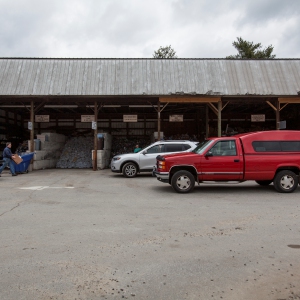Hungry herbivores have encouraged plant life to seek different protection mechanisms
| Published: 06-17-2023 2:00 PM |
It’s not easy being green . . . a green plant that is. Whether a plant is a tree in the forest, a shrub in a park, a wildflower in a meadow or a vegetable in your garden, there are likely hungry herbivores seeking to convert the plant into a meal. So how do they survive?
Plants have evolved many types of defenses. Protective mechanisms can be structural such as thorns, prickles, or textured leaves; or they can be chemical including toxic compounds or sap that causes skin irritations. Rather than dreading encounters with such features, it’s interesting to explore why they exist and how they help a plant.
The common mullein is a plant that was brought to North America by European colonists because of its use as medicine or dye. It is a biennial plant, meaning that it only grows leaves the first year and in the second year also produces yellow flowers and seeds on a tall stalk. The leaves are oval, quite large (4-12” long), and are covered with a dense soft pubescence or fuzz. The wooliness is caused by interlocking branched hairs. Look for them with a magnifying glass. The leaves may be pleasant and soft to touch, but the texture makes them less palatable to insects and grazing mammals. Leaves may be nibbled but are rarely devoured, leaving plenty to photosynthesize and make food for the plant.
More dramatic textures come in the form of prickles, spines, and thorns. When trying to avoid these sharp protrusions, you may not care that there is a difference between them, but botanically there is. The distinctions can help with plant identification. Prickles derive from the epidermis or bark and do not grow from the wood of the plant. Spines are firm, slender modified leaves or form on leaf margins. Thorns are stout, woody modified stems. Another way to distinguish them is by their position, prickles are found all along a stem, spines are born in the position of a leaf or below it and thorns form above a leaf where a new branch would grow.
Local examples of these piercing and painful protections include blackberries, raspberries and roses which have prickles, not thorns. True thorns are found on hawthorns, locusts and flowering quince. Holly leaves sprout spines, as do cactus plants. Needless to say, all of these sharp projections greatly deter herbivores from munching on a plant.
Less obvious deterrents include waxy coatings on leaves. This is a modification that helps leaves retain water and is common on evergreen trees and shrubs. The waxy texture can also make them less appetizing. Examples include most conifers, rhododendrons, azaleas, and hellebore. This may not be as strong a defense as thorns if deer or other mammals are particularly hungry, but waxiness ensures that these plants are not the first thing on the menu.
A strong fragrance can also discourage browsing. Plants like lavender, mints, anise hyssop, peonies, salvia, onions and any of the strong culinary herbs are plants that tend to be avoided by most mammalian munchers. Bordering a garden with some of these plants can help to deter unwanted guests.
Other chemical mechanisms include various levels of strong tastes or toxicity. Calendula tastes bitter. Daffodils, foxgloves and lily-of-the valley are toxic. Animals that take small bites of these plants will cease their snacks quickly and learn to avoid them.
Article continues after...
Yesterday's Most Read Articles
 Hopkinton tries to nab out-of-town trash bandits
Hopkinton tries to nab out-of-town trash bandits
 UNH faculty and students call on university police chief to resign following his alleged assault on a student
UNH faculty and students call on university police chief to resign following his alleged assault on a student
 Steeplegate project to reopen to public comment as developer seeks to reduce required parking
Steeplegate project to reopen to public comment as developer seeks to reduce required parking
 Monitor Way developer seeks $4.67 million from city for proposed new road
Monitor Way developer seeks $4.67 million from city for proposed new road
 Northeast Coffee Festival comes to Concord this weekend
Northeast Coffee Festival comes to Concord this weekend
 NH Senate panel frowns on bill to ease vehicle inspection requirements
NH Senate panel frowns on bill to ease vehicle inspection requirements
Some of these defenses are effective with one group of predators but not with others. Various species of milkweed are a great example. If eaten by mammals, depending on the amount that is consumed, the plant can lead to death. Yet monarch butterfly caterpillars have adapted to feed exclusively on milkweed leaves, ingesting cardenolides (which cause cardiac arrest in other creatures) without negative impact. In fact, the chemical remains in their system, making them toxic to birds.
These survival tricks work to reduce, not eliminate predation, which is important in the grand scheme of things. If every plant had a foolproof survival adaptation, there would be nothing for the herbivores to eat and the great food web would not exist. The next time you encounter a plant, consider what features it employs to survive, as well as the important role it may play in feeding other members of the food web.
]]>


 Adam Montgomery sentenced to minimum 56 years on murder charges in young daughter’s death
Adam Montgomery sentenced to minimum 56 years on murder charges in young daughter’s death Neighboring landowner objection stalls Steeplegate redevelopment approval
Neighboring landowner objection stalls Steeplegate redevelopment approval Following budget cut, Pembroke revisits future of elementary school re-build
Following budget cut, Pembroke revisits future of elementary school re-build Granite Geek: Free government software for taxes – what could go wrong? (Not much, as it turns out)
Granite Geek: Free government software for taxes – what could go wrong? (Not much, as it turns out)
